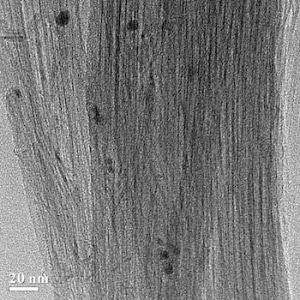Oct 17 2017
Scientists at Rice University suggest that it is best to start with long nanotubes in order to make continuous, conductive and strong carbon nanotube fibers.
 Iron impurities are easy to see in a bundle of carbon nanotubes viewed through a transmission electron microscope. Researchers at Rice University and the National University of Singapore are leading the charge to purify nanotubes for use in continuous, strong and conductive carbon nanotube fibers. Courtesy of the Pasquali Group
Iron impurities are easy to see in a bundle of carbon nanotubes viewed through a transmission electron microscope. Researchers at Rice University and the National University of Singapore are leading the charge to purify nanotubes for use in continuous, strong and conductive carbon nanotube fibers. Courtesy of the Pasquali Group
The Rice lab of Chemist and Chemical Engineer Matteo Pasquali, which proved its pioneering method to spin carbon nanotube into fibers in the year 2013, has now improved the art of creating nanotube-based materials with two new papers in the American Chemical Society’s ACS Applied Materials and Interfaces.
In the first paper, 19 batches of nanotubes were characterized for producing as many manufacturers in order to determine which nanotube characteristics produce the most strongest and conductive fibers for use in large-scale aerospace, textile and consumer electronics applications.
The Researchers were able to determine the aspect ratio of the nanotubes — length versus width — considered to be a vital factor, as is the complete purity of the batch. They discovered that the tubes’ diameters, crystalline quality and number of walls are not as vital to the product properties.
Pasquali stated that while the aspect ratio of nanotubes was believed to have an influence on fiber properties, this is the very first systematic work to begin the relationship across a wide variety of nanotube samples. Researchers studied that it is possible to process longer nanotubes as well as shorter ones, and that electrical conductivity and mechanical strength are increased in lockstep.
The best fibers are available with an average tensile strength of 2.4 gigapascals (GPa) and electrical conductivity of 8.5 megasiemens per meter, almost 15% of the conductivity of copper. Increasing nanotube length during synthesis will help in providing a path toward further property improvements, Pasquali stated.
The second paper concentrated on purifying fibers developed by the floating catalyst method for use in aerogels and films. This process is efficient, fast and cost-effective on a medium scale and is capable of yielding the direct spinning of superior-quality nanotube fibers; however, it leaves behind impurities, including bits of leftover carbon and metallic catalyst particles, limits opportunities to scale up and allows less control of fiber structure, Pasquali said.
That’s where these two papers converge. There are basically two ways to make nanotube fibers. In one, you make the nanotubes and then you spin them into fibers, which is what we’ve developed at Rice. In the other, developed at the University of Cambridge, you make nanotubes in a reactor and tune the reactor such that, at the end, you can pull the nanotubes out directly as fibers.
Matteo Pasquali, Chemist and Chemical Engineer, Rice University
“It’s clear those direct-spun fibers include longer nanotubes, so there’s an interest in getting the tubes included in those fibers as a source of material for our spinning method,” Pasquali said. “This work is a first step toward that goal.”
Materials Scientist Alan Windle at the University of Cambridge developed the reactor process a decade ago, and this process produces the requisite long nanotubes and fibers in one step, but it is essential for the fibers to be purified, Pasquali said. Researchers at Rice and the National University of Singapore (NUS) have come up with a simple oxidative method in order to clean the fibers and then make them usable for an extensive range of applications.
Fiber samples were purified by the labs in an oven, first burning out carbon impurities in air at 500 oC (932 oF), followed by immersing them in hydrochloric acid in order to dissolve iron catalyst impurities.
Impurities in the resulting fibers were decreased to 5% of the material, which made them soluble in acids. The nanotube solution was then used by the Researchers in order to make conductive, transparent thin films.
There is great potential for these disparate techniques to be combined to produce superior fibers and the technology scaled up for industrial use. The floating catalyst method can produce various types of nanotubes with good morphology control fairly quickly. The nanotube filaments can be collected directly from their aerogel formed in the reactor. These nanotube filaments can then be purified and twisted into fibers using the wetting technique developed by the Pasquali group.
Hai Minh Duong, Co-author and NUS Assistant Professor of Mechanical Engineering
Pasquali highlighted the association between Rice and Singapore represents convergence of another kind.
This may well be the first time someone from the Cambridge fiber spinning line (Duong was a postdoctoral researcher in Windle’s lab) and the Rice fiber spinning line have converged. We’re working together to try out materials made in the Cambridge process and adapting them to the Rice process.
Matteo Pasquali, Chemist and Chemical Engineer, Rice University
Alumnus Dmitri Tsentalovich, presently an Academic Visitor at Rice, is main Author of the characterization paper. Co-authors include Graduate Students Robert Headrick and Colin Young, Research Scientist Francesca Mirri and Alumni Junli Hao and Natnael Behabtu, all of Rice.
Thang Tran of Rice and NUS and Headrick are Co-lead Authors of the catalyst paper. Co-authors include Graduate Student Amram Bengio and Research Specialist Vida Jamali, both of Rice, and Research Scientist Sandar Myo and Graduate Student Hamed Khoshnevis, both of NUS.
Both projects were supported by the Air Force Office of Scientific Research, the Welch Foundation and NASA. The characterization project received further support from the Department of Energy. The Temasek Laboratory in Singapore provided additional support for the catalyst project.